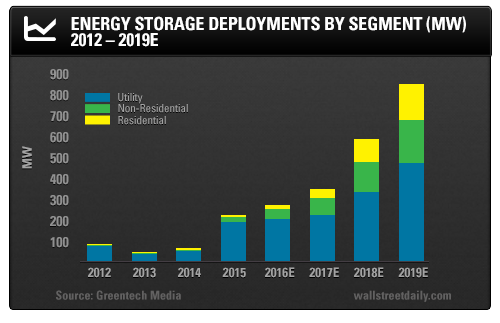As my colleague, Tim Maverick, discussed on Tuesday, battery technology is becoming an integral part of our electric grid system.
Indeed, competition among creators of energy storage technology is heating up.
For investors, that means there are several new opportunities for us to power our portfolios with this critical energy development.
Positively Charged
Indeed, batteries are set to solve one of the primary issues with renewable energy. That is, the sun may be shining or the wind blowing, but not necessarily in the right place or at the right time.
Baseload power generated by fossil fuel or nuclear power is typically necessary to compensate for cloudy or breezeless days.
What’s more, batteries for energy storage are generally considered expensive and thus an uneconomical solution.
Until now.
In certain markets, energy storage technologies are now cost competitive with conventional grid electricity, according to the asset management team from Lazard.
It recently worked with Enovation Partners, a consultant to the power and energy industry, to publish an in-depth study on the levelized cost of energy storage.
While measuring storage may sound simple, it’s far from it. Concrete cost figures are difficult to come by, complicated in part because storage can be measured in many ways, including:
- How much stored energy provides power during downtimes
- How much stored energy obviates the need to construct new power plants
- How much level of enhancement stored energy provides to grid reliability
The Lazard study laid out a range of cost scenarios including both “in front of the meter” (power grid-oriented) and “behind the meter” (distributed) systems, and the results are surprisingly positive.
As it turns out, energy storage is rapidly becoming cost competitive.
The results reveal significant capital cost declines expected for selected energy storage technologies over the next five years, driven primarily by increased manufacturing scale and design, engineering improvements, and the increasing use of renewable energy, as well as policies supporting energy storage.
The cost of lithium batteries, for example, is expected to drop by 50% in 10 years.
And even though it’s not cost competitive on a grand scale, battery storage is already the preferred option in a number of scenarios, such as replacing major new transmission lines or installing micro grids.
As with all economies of scale, the costs will continue to decline as more batteries are installed. That, in turn, will allow more renewable energy to come online. This scaling will bring down costs even further, allowing for faster penetration.
At the same time, the cost of transmission and fossil fuel-based power generation is likely to go in the other direction. The term “utility death spiral” refers to the simultaneous rising of electricity rates and falling renewable energy costs, the result of which causes ratepayers to rapidly abandon the grid.
From there on, rates are forced up to compensate for a smaller market for ratepayers and, in turn, more renewable energy will come online.
Aging Power Grid
As the power grid ages, it validates the argument for more energy storage – especially given the need for more transmission lines, which are expensive to maintain.
Consider the amount of energy storage deployment estimated to take place in the next four years:

According to Navigant, energy storage could grow from 196 megawatts (MW) today to over 12,700 MW by 2025.
Public policy is contributing to this growth. Oregon, for example, is requiring major utilities to install five MW of energy storage by 2020, while California already has a battery storage mandate in place.
Energy storage can displace a notable amount of gas-fired generation capacity and, in particular, could replace peaking gas turbine facilities, allowing for greater integration of renewable energy.
Peaker plants, which are used during periods of high demand, are more expensive than typical power plants. But as batteries become the more cost-effective option, peaker plants may no longer be necessary.
Investing in Storage
There are a number of energy storage manufacturers as well as service providers to the industry.
While Tesla Motors Inc (O:TSLA) and its Gigafactory typically come to mind, other names include American Vanadium Corp (TO:AVC), an integrated energy storage company, and Maxwell Technologies Inc (O:MXWL), an American developer and manufacturer.
Or, if you don’t want to invest in individual companies, you might consider the NASDAQ OMX Energy Storage.
Of course, there’s still a ways to go before battery storage can compete on a grand scale.
But its benefits are being seen on multiple fronts – from a deferred over-investment on generation, transmission, and distribution infrastructure and a reduced need for peakers, to the ability to accelerate renewables deployment and form a more efficient and reliable grid.
Last but not least, batteries are helping reduce price volatility. And these benefits are increasingly making battery storage a competitive force in electric power markets.
Good investing,
